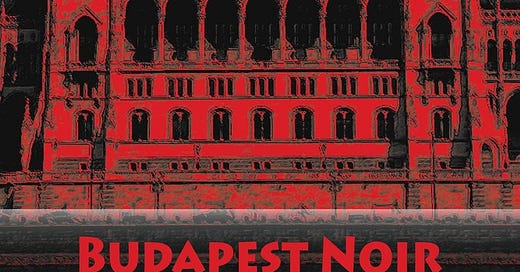Review: Ilona Gets A Phone
Alexander Faludy reviews Alison Langley’s debut novel, Ilona Gets a Phone (2024)
Ilona Kovács didn’t have a phone under communism. Being both a class enemy and the widow of a participant in the 1956 uprising, she was passed over while such amenities were being installed in her ‘panel house’ apartment building. She had to wait until 1991 for a technician to call.
Finally, Ilona is able to hear the reassuring soft buzz of a dial tone in her ear without having to trouble her neighbour, Erzsi, across the corridor. Now she can ring her photographer son, Emil, in Ohio. Emil defected to the West as a teenager: a move which cost Ilona her factory job —and a tooth when the ÁVH (the Hungarian secret police) came calling. However, before she can find out Emil’s number, he arrives in person, American wife and baby in toe, hoping to become reacquainted with both his mother and his homeland.
To Ilona’s distress though, Emil is more interested in photographing people for his exhibition (‘Hungary in Transition’) than reclaiming the family mansion, confiscated in the 1940s. His wife Melissa has decidedly puzzling views on vegetarianism, the virtues of wholemeal bread and not feeding children sugary food. Life for the four of them in Ilona’s one-bedroom flat rapidly becomes fractious.
For those of us who first encountered Hungary in the early 1990s, Langley’s novel is evocative. It captures the rough and ready atmosphere of a modern country being improvised into being. Langley was herself a journalist covering those changes and she artfully ‘textures’ her descriptions in regard to both emotional tenor and physical setting. The mix of excitement, disappointment, and (seemingly paranoid) fearfulness that competed in social life and individual psyches comes across clearly —sometimes manifested by a single speaker during a conversation.
There were important environmental differences between then and now which Langley presses to consciousness. Today, Budapest in July and August is scarcely habitable thanks to global warming. But in the early 1990s, the ambient low-level smog belched by ageing Trabants and Wartburgs reacting with the summer sun produced an oppressive microclimate: trapping heat and clogging lungs. Din from the cars’ exhausted mechanisms (not properly renewable thanks to a ‘material dialectic’ of collapsing supply chains and financial shortages) compounded the sensory overload.
Langley conjures this atmosphere well —and not just as a point of antiquarian interest. In the summer scenes, the heat and airlessness plays on the characters: shortening tempers and magnifying tensions.
Budapest then, though magical, seemed far more ‘other’, to outsiders. Melissa’s disorientation, physical and emotional, in a Budapest flea market has distant echoes of E.M. Forster’s treatment of a comparable, but different, scenario in the “Maribar Caves” incident in A Passage to India. It’s one of the novel’s high points.
Ironically, Melisa recovers her bearings in an improvised commercial art gallery where a boorish, West German collector is demanding the proprietor separate historic Hungarian paintings from their frames so he can purchase the latter. Of course, it’s Melissa who already lost her ‘frame of reference’.
As the plot nears resolution, Langley also excavates the tap roots of resentments that would later blossom into support for Orbánism through the experience of characters like István, Emil’s childhood friend. That political choice was very flawed — Langley is no apologist for Fidesz— but she shows us how it wasn’t, strictly speaking, ‘irrational’: emotions and experience create their own rationality.
To those who lived through the social trauma of market reforms accompanying the sale of state firms to foreign investors during the ‘Wild East’ period, the appeal of a strongly nationalist and ‘sovereignist’ message is obvious. Langley’s narrative exploration of social problems elucidates how those choices became possible and insight makes this book useful to those who want to understand Hungary better.
This is a first novel and sometimes shows it. In places, readers are aware of the joins —of a writer “showing her workings.” In particular, simile is sometimes used where metaphor would work better. Seeing through the eyes of teenage Ilona, we witness her father’s murder at the hands of a Soviet officer who comes to requisition their estate’s produce amid the post-war food crisis. The scene would register with greater force if we read “a red halo spread around his head on the floor” rather than (as written) that Ilona saw “blood forming around his head like a grotesque halo”.
That’s because in crisis moments we encounter, and only partially decode, shapes and colours ‘raw’ before we know what they are or what they signify. Only later do we assemble them into an orderly picture and label them accurately. We can’t craft comparisons or make judgements in the din of shock: similes and adjectives take us into the mind of the writer at her desk, not that of Ilona observing confusedly at the top of the stairs.
Identifying Ilona as a member of a real, and famous, Hungarian noble family (the Pálffys) could raise eyebrows, especially as the book contains no historical note on the family or a disclaimer that “resemblance to any real persons living or dead is purely coincidental”. Yet, as Illona is able, ultimately, not only to obtain a phone but, also, to conquer our sympathies, the coincidence is probably benign.
Ilona Gets A Phone
by Alison Langley (Dedalus Books, 2024)
Alexander Faludy





